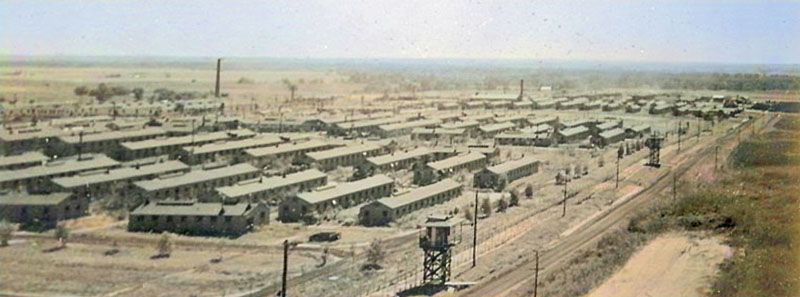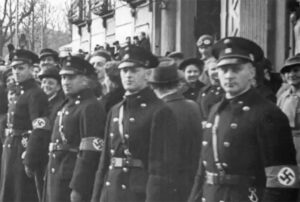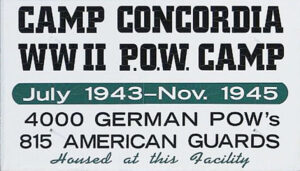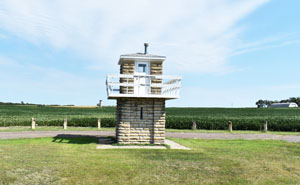Camp Concordia was a prisoner-of-war (POW) camp in Cloud County, Kansas. It operated from 1943 to 1945 and was about two miles north and one mile east of Concordia. The camp was used primarily for German Army prisoners captured in battles in Africa during World War II.
During the war, 400,000 German Prisoners of War were interned in the United States, many of whom were shipped to Kansas. Typically, they were housed in small camps of 100 or fewer in places such as El Dorado, Hutchinson, Cawker City, Hays, and Topeka, Ottawa. However, there were three larger camps in Kansas, including Camp Phillips near Salina, one at Fort Riley, and Camp Concordia, just outside Concordia, Kansas. The camp in Concordia was the largest POW camp in Kansas, holding over 4,000 prisoners. The camp consisted of a complex of 300 buildings and was staffed by 800 United States soldiers.
Construction of Camp Concordia began in February 1943, and the POW camp was turned over to the U.S. Army on May 1, 1943. The camp cost $1,808,860 to build, running $40,000 over budget. Built in just 90 days, it had 304 buildings, including a 177-bed hospital, a fire department, warehouses, cold storage, an officers’ club, barracks, mess halls, and administrative buildings for both German POWs and American soldiers.
The prisoners arrived at Camp Concordia by train. They then provided labor for area farms and other projects, including the railroad and the ice plant. Army trucks transported the POWs to the surrounding farms and other work locations, where they earned a small wage from the farmers for their work. POWs were housed, fed, clothed, and allowed to send mail. Difficulties between POWs and residents were few, and in some cases, friendships were formed. Life at the camp was easy compared with the war in Europe. Prisoners played outdoor sports, had their own band and a newspaper, and took courses offered by the University of Kansas. The camp was run according to the rules outlined in the Geneva Convention of July 1929, which required the humane treatment of prisoners.
Camp Concordia was built as a model POW camp. However, because about 50 of the first prisoners were Nazi officers, some hardcore Nazi ideologues began to intimidate the mass of POWs, who, although patriotic Germans, were unsympathetic to fascism. The atmosphere quickly turned oppressive and threatening, resulting in several violent episodes.
In the fall of 1943, there was a series of mysterious deaths in the camp. Initially, they were deemed suicides until it was later discovered that the victims had expressed anti-Nazi sentiments and, in some cases, had already received threats from Nazi sympathizers in the camp. This type of problem was persistent at camps all over America. At that time, it was estimated that about 25% of camp prisoners were fanatical Nazis, 15% anti-Nazi, and 60% somewhere in between. Dedicated Nazis were quick to organize in the camps, and any German prisoner who showed interest in democracy or appeared unsympathetic to Nazi ideals ran the risk of retribution from their fellow prisoners.
A December 1943 inspection report noted, “The prisoners were running their own companies with no American officer assigned to any company.” Moreover, prisoners handled most of the disciplinary actions and company administrative policies. After several violent episodes, the Army transferred 44 Nazi leaders away from Concordia to a secure camp at Alva, Oklahoma. As measures of restoring order, the library removed Nazi reading material from the library and instituted college coursework for prisoners under the jurisdiction of the University of Kansas.
The U.S. Government believed it was possible to re-educate the German soldiers and that they could be disabused of their harmful Nazi ideology and converted to modern American democratic values. The curriculum taught at Concordia included approximately 300 subjects, including English, 12 additional languages, electronics, theology, history, geography, government, engineering, medicine, arts, sciences, and vocational subjects. Within a very short time after their arrival, prisoners had constructed an open-air stage, and much time was dedicated to music, the arts, and theater.
At its peak, Camp Concordia had 4,027 Prisoners, 880 soldiers, and 179 civilian Employees.
The camp saw only two escapes during its tenure, but they were unsuccessful. There were eight POW deaths during its operation.
There were at least two reported cases of executions recorded at the camp when prisoners made allegations against other prisoners, some of whom were Gestapo agents. When conclusive evidence arose, the offenders were tried and sentenced to the federal penitentiary at Leavenworth, Kansas.
On May 7, 1945, the Germans officially surrendered. The prisoners began to be returned to Germany in the autumn of 1945, with the last prisoners departing on October 31, 1945. Camp Concordia officially closed on November 8, 1945.
After its closure, many buildings were torn down, and others were moved. Some are still serving as homes in Concordia. One of the buildings, Building T-9, was on a list acquired by the Federal Land Bank in June 1947. A few months later, the City of Concordia purchased 166.7 acres of camp acreage, including buildings, In October 1947 to establish a park and relocate the Cloud County fairgrounds to the site. However, plans for the park never came to pass, and the city eventually sold Building T-9, along with other buildings and acreage. T-9 was subsequently used as a skating rink, a hog farm, a canoe factory, and, during the 1960s, as storage for a horse racetrack called Thundercloud Park
Today, several camp structures remain at the site, including a prison warehouse used for storage, an officers’ club, some stone walls, and a restored guard tower. However, only the guard tower is easily accessible to the public. The land is primarily used for farming, although some houses have also been built. The original guardhouse remains and has been restored. Today, correspondence continues between former POWs, their relatives, and Concordia residents.
Camp records have been transferred and are maintained at the Cloud County Historical Museum in Concordia. The museum also displays many items of interest about Camp Concordia, including several original paintings created by prisoners. The POW Camp Concordia Museum is located at 1550 Union Road in Concordia. The Museum contains many interesting displays and artifacts with incredible stories unique to other POW Camps nationwide.
To visit the Camp Concordia museum, please call ahead to make arrangements. The museum is volunteer-run and does not open regularly. Call Cloud County Tourism at (785) 243-4303 to schedule a tour. The POW Camp Concordia is closed during the colder months as there is no heat at the camp.
©Kathy Alexander/Legends of Kansas, updated June 2025.
Also See:
Sources:
Cloud County Tourism
Kim’s County Line
New Prairie Press
POW Camp Concordia
Wikipedia






